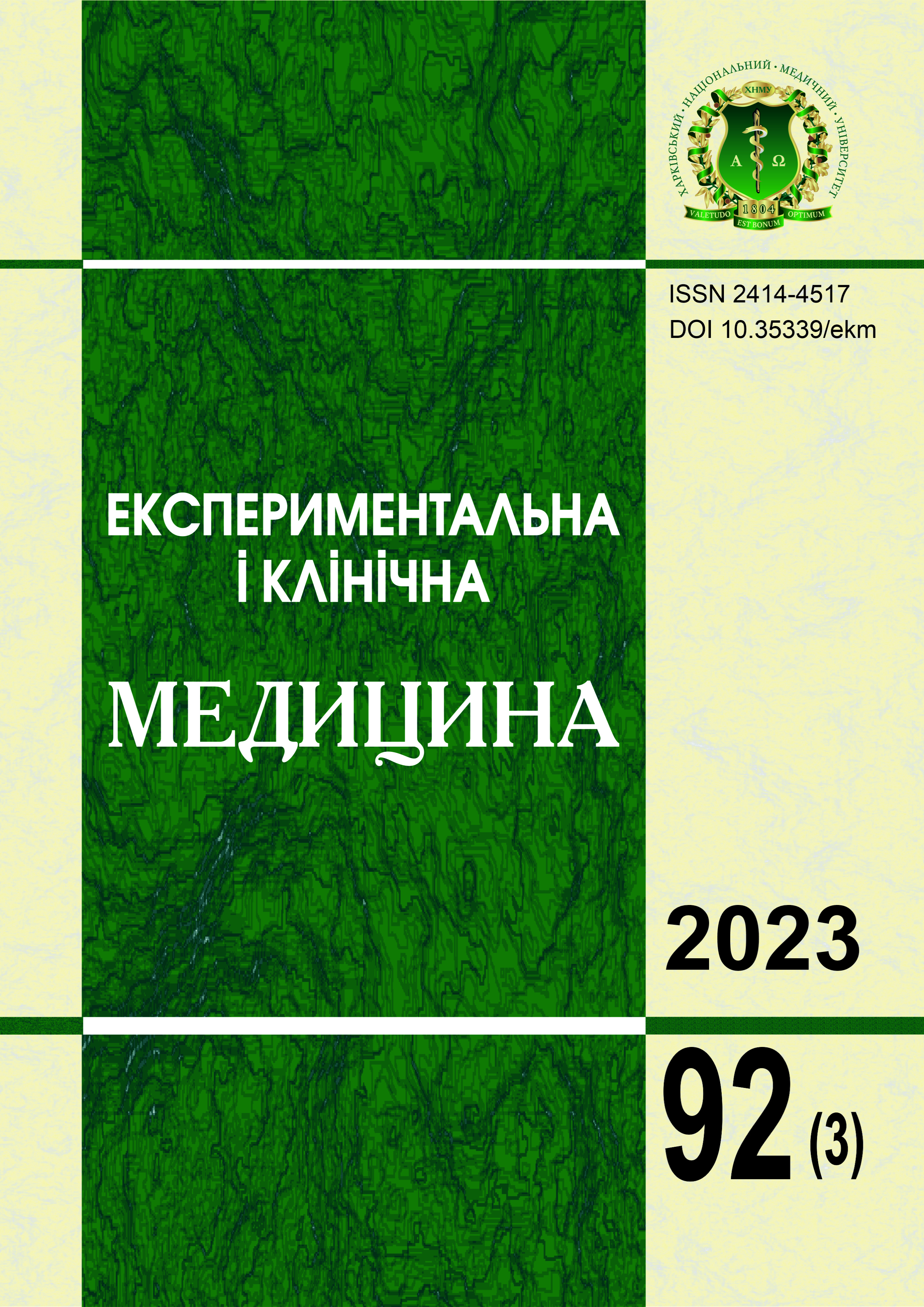Abstract
Research of comorbid coronary heart disease (CHD) and obesity in recent years often rely on the study of inflammatory mediators, among which the first and foremost are batokines, in particular on fibroblast growth factor (FGF-21) and vascular endothelial growth factor A (VEGFa). The aim of our study was to determine the correlational interdependencies of indicators of carbohydrate metabolism and lipid profile and levels of batokines in the comorbidity of CHD and obesity. 70 people aged from 25 to 85 were examined with CHD on the background of obesity. The average age was (63.6±8.8) years. The research do not violate the principles of bioethics, which is confirmed by the conclusion of the Bioethics Committee of the Kharkiv National Medical University. All patients who participated in the study signed an informed voluntary consent. Based on the results of research probable direct strong correlations of total cholesterol (TC) with low-density lipoprotein (LDL) were determined (ρ=0.889; p=0.000); triglycerides (TG) with very low-density lipoprotein (VLDL) (ρ=0.810; p=0.000). The average strength of correlation was determined: glycosylated hemoglobin (HbA1c) with vascular endothelial growth factor A (VEGFA) (ρ=0.374; p=0.001); TC and LDL and AI (respectively ρ=0.615; p=0.000, and ρ=0.648; p=0.000); VLDL with atherogenic index (AI) (ρ=0.367; p=0.002). Probable direct weak correlations of blood glucose levels with TG (ρ=0.253; p=0.034) and VLDL (ρ=0.277; p=0.020) and VEGFA (ρ=0.225; p=0.061) were found; TG and VLDL with VEGFA (ρ=0.256; p=0.032 and ρ = 0.273; p = 0.022, respectively). Inverse interdependencies were recorded: medium strength – high-density lipoprotein (HDL) and AI (ρ=-0.583; p=0.000) and weak – hemoglobin levels with HDL (ρ=-0.251; p=0.036); HbA1c with LDL (ρ=-0.241; p=0.044); HDL with VLDL (ρ=-0.293; p=0.014).
Keywords: comorbidity of coronary heart disease and obesity, batokines, FGF21, VEGFA.
References
Remus Popa A, Fratila O, Rus M, Anca Corb Aron R, Mihai Vesa C, Pantis C, et al. Risk factors for adiposity in the urban population and influence on the prevalence of overweight and obesity. Exp Ther Med. 2020;20(1):129-33. DOI: 10.3892/etm.2020.8662. PMID: 32509005.
Yuyun MF, Sliwa K, Kengne AP, Mocumbi AO, Bukhman G. Cardiovascular Diseases in Sub-Saharan Africa Compared to High-Income Countries: An Epidemiological Perspective. Glob Heart. 2020;15(1):15. DOI: 10.5334/gh.403. PMID: 32489788.
GBD 2017 DALYs and HALE Collaborators. Global, regional, and national disability-adjusted life-years (DALYs) for 359 diseases and injuries and healthy life expectancy (HALE) for 195 countries and territories, 1990-2017: a systematic analysis for the Global Burden of Disease Study 2017. Lancet. 2018;392(10159):1859-922. DOI: 10.1016/S0140-6736(18)32335-3. PMID: 30415748.
Lykhota KO, Zakaliuzhnyi VM. Cardiovascular diseases and the health of the population of Ukraine: materials of the International science and practice conference "Methodology of teaching natural sciences in secondary and higher schools (XXVIII Karyshyn readings)". Poltava, Ukraine; 2021. Р. 205-7. [In Ukrainian].
Janssen JAMJL. Hyperinsulinemia and Its Pivotal Role in Aging, Obesity, Type 2 Diabetes, Cardiovascular Disease and Cancer. Int J Mol Sci. 2021;22(15):7797. DOI: 10.3390/ijms22157797. PMID: 34360563.
Jung E, Romero R, Yeo L, Gomez-Lopez N, Chaemsaithong P, Jaovisidha A, et al. Am J Obstet Gynecol. 2022;226(2S):S844-6. DOI: 10.1016/j.ajog.2021.11.1356. PMID: 35177222.
Wittenbecher C, Cuadrat R, Johnston L, Eichelmann F, Jäger S, Kuxhaus O, et al. Dihydroceramide- and ceramide-profiling provides insights into human cardiometabolic disease etiology. Nat Commun. 2022;13(1):936. DOI: 10.1038/s41467-022-28496-1. PMID: 35177612.
Manrique-Acevedo C, Chinnakotla B, Padilla J, Martinez-Lemus LA, Gozal D. Obesity and cardiovascular disease in women. Int J Obes (Lond). 2020;44(6):1210-26. DOI: 10.1038/s41366-020-0548-0. PMID: 32066824.
Knuuti J, Wijns W, Saraste A, Capodanno D, Barbato E, Funck-Brentano C, et al. 2019 ESC Guidelines for the diagnosis and management of chronic coronary syndromes. Eur Heart J. 2020;41(3):407-77. DOI: 10.1093/eurheartj/ehz425. PMID: 31504439.
Hebebrand J, Holm JC, Woodward E, Baker JL, Blaak E, Durrer-Schutz D, et al. A proposal of the European Association for the Study of Obesity to Improve the ICD-11 Diagnostic Criteria for Obesity Based on the Three Dimensions Etiology, Degree of Adiposity and Health Risk. Obes Facts. 2017;10(4):284-307. DOI: 10.1159/000479208. PMID: 28738325.
Babak OY, Lapshyna KA. The fibroblasts growth factor 21 study in patients with non-alcoholic fatty liver disease and hypertension comorbidities. Zaporozhye Medical Journal. 2020;22(2):161-5. DOI: 10.14739/2310-1210.2020.2.200572. [In Ukrainian].

This work is licensed under a Creative Commons Attribution-NonCommercial-ShareAlike 4.0 International License.

